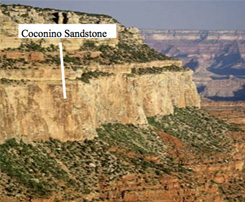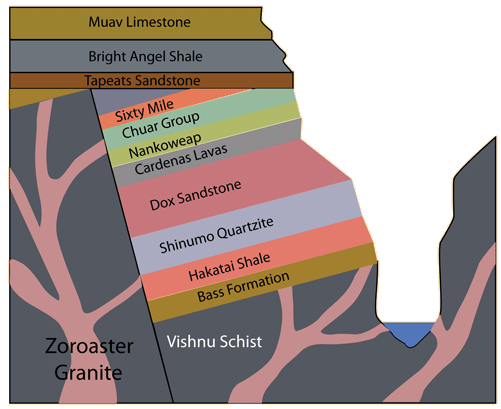Grand Canyon and Grand Staircase
A showcase of the history of sedimentary rock
The Grand Canyon and the layered formations north of it to Zion Canyon and Bryce Canyon display the history of sedimentary rock through much of Earth's history. The formations rise in what is often called the "grand staircase". The multiple layers offer an opportunity to survey many types of sedimentary formations. The illustration below will be used as a key to the discussion of the multiple formations. This illustration is patterned after one in "The Grand Canyon", C. Hill, et al., eds, Figure 3-2 and a similar color scheme is followed for organization of the comments.
Because the Grand Canyon exposes a large fraction of the Earth's geologic history, it has been the subject of intensive study. A recent review of studies up to 2020 by Karlstrom, Crossey, Mathis and Bowman, Telling Time at Grand Canyon National Park, summarizes the efforts to accurately date the features of the Canyon. An even more recent review of this material can be found in the National Park Service's website which is beautifully illustrated and includes updates on the "Telling Time .." article.
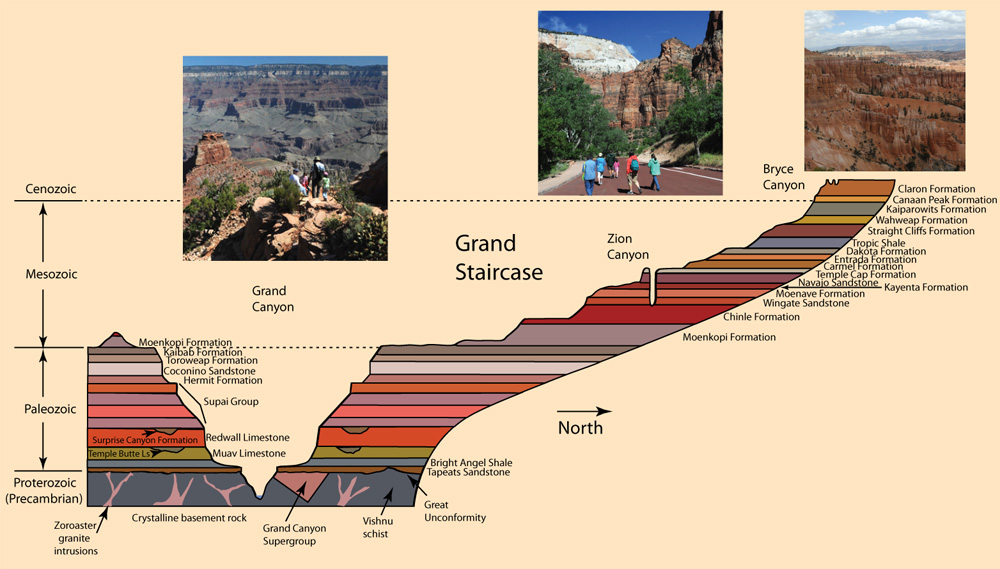
 | Claron FormationThe Claron Formation is a lake deposit (limestone) from the Cenozoic Era containing fossils of freshwater fish and an abundance of fossils of freshwater snails.(Hill,et al.,Ch3) The unique pillars of Bryce Canyon, called hoodoos, are carved into this formation. There are fossils of animals like bison and of flowering plants, but none of the extinct species such as trilobites and dinosaurs.(Hill,et al.,Ch4) Caanan Peak FormationNamed for exposures of this formation around Caanan Peak, this formation is mostly a coarse clastic unit characterized by gray, tan, light-brown and pink conglomerates and conglomeratic sandstones. The material is thought to be associated with river and stream deposition and varies in thickness from about 40ft to 1000 ft. It sits atop the Kaiparowits Formation but is mostly absent in the Bryce Canyon area. It is associated with the Paleocene epoch. USGS report, Wiki Kaiparowits FormationThe Kaiparowits Formation is placed in the Mesozoic Era, Cretaceous Period. The fossils found there are terrestrial fossils: frogs, lizards, turtles, crocodiles, duckbill dinosaurs, horned dinosaurs, theropod dinosaurs, and marsupial mammals. (Hill,et al.,Ch13) It is characterized by gray sandstones and mudstones, and is in the neighborhood of 100ft (30m) thick in the Bryce Canyon area. Wiki |
 | Wahweap FormationThe Wahweap Formation is placed in the Mesozoic Era, Cretaceous Period. It has sandstone and siltstone and is the source of a significant variety of invertebrate fossils: insect burrows in petrified logs, mollusks, crabs, gastropods. Freshwater fish fossils have been recovered: bowfin, rays, probable lungfish burrows. Several dinosaur fossils have been found: hadrosaur, ceratopsian, theropod. Wiki.Straight Cliffs FormationThe Straight Cliffs Formation is placed in the Mesozoic Era, Cretaceous Period. The fossils found there are terrestrial fossils: frogs, lizards, turtles, crocodiles, duckbill dinosaurs, horned dinosaurs, theropod dinosaurs, and marsupial mammals. (Hill,et al.,Ch13)Tropic ShaleThe Tropic Shale formation is placed in the Mesozoic Era, Cretaceous Period. Fossils found there include ammonites, sharks and plesiosaurs. (Hill,et al.,Ch13) |

Dakota Formation
The Dakota Formation is placed in the Mesozoic Era, Cretaceous Period. Fossil pollen and spores have been collected here. (Hill,et al.,Ch14)
Entrada Formation
The Entrada Formation is placed in the Mesozoic Era, Jurassic Period. The fossils found there are dinosaur bones and tracks. (Hill,et al.,Ch13)Carmel Formation
The Carmel Formation (limestone) dating to the Mesozoic Era, Jurassic Period, contains many fossil examples of marine fauna. There are many marine invertebrates including corals, crinoids, oysters and other bivalves, and the extinct cephalopods known as ammonites. (Hill,et al.,Ch13)
Temple Cap Formation
Navajo Sandstone
The Navajo Sandstone is placed in the Mesozoic Era, Jurassic Period. The fossils found there are dinosaur bones and tracks. (Hill,et al.,Ch13)Kayenta Formation
The Kayenta Formation is placed in the Mesozoic Era, Jurassic Period. The fossils found there are dinosaur bones and tracks. (Hill,et al.,Ch13)Moenave Formation
Wingate Sandstone
Chinle Formation
"The Chinle Formation s placed in the Mesozoic Era, Triassic Period. It consists of colorful mudstones and siltstones that erode to form the low, rounded hills of Arizona's Painted Desert and Petrified Forest National Park."(Hill,et al.,Ch13) Fossils preserved here are many primitive conifer trees and several groups of plants that do not appear in underlying Paleozoic rocks. There are also fossils of insects and scorpions, freshwater fish and a variety of tetrapods. There are fossils of early dinosaurs. Hill, et al. lists freshwater clams, crayfish, beetles, lungfish, phytosaurs, aetosaurs, and an early bipedal dinosaur, Coelophysis. No marine organisms of any kind have been found in the Chinle Formation.
Moenkopi Formation
The Moenkopi Formation is placed in the Mesozoic Era, Triassic Period. The fossils found there are mostly terrestrial fossils. Findings include large amphibians, tracks, and coelacanth fish. (Hill,et al.,Ch13) | Kaibab FormationThe Kaibab Formation is placed in the Paleozoic Era, Permian Period. The fossils found there are marine fossils: sponges, corals,brachiopods, bryozoans, gastropods, pelecypods, nautiloids, sharks and bony fish. Trilobites are found, but are rare.(Hill,et al.,Ch13) The projected age is 270 Myr (Hill et. al., Karlstom, et. al.).Toroweap FormationThe Toroweap Formation is placed in the Paleozoic Era, Permian Period. The fossils found there are marine fossils: sponges, corals,brachiopods, bryozoans, gastropods, pelecypods, nautiloids, sharks and bony fish. Trilobites are found, but are rare.(Hill,et al.,Ch13) The projected age is 275 Myr (Karlstom, et. al.).Coconino Sandstone
Hermit FormationWith a projected age of about 285 Myr (Karlstom, et. al.) in Permian Period, this formation is made of soft, easily eroded shales which have formed a slope. Its softness has undermined the layers of sandstone and limestone above it and caused large blocks to fall to the lower parts of the canyon. It contains fossils of ferns, conifers and other plants, as well as fossilized tracks of reptiles and anphibians. |
 |
Supai GroupThe Supai Group is placed in the Paleozoic Era, Mississippian and Pennsylvanian Periods. The fossils there are marine fossils: brachiopods, gastropods, pelecypods,corals,bryozoans, conodonts, sharks. (Hill,et al.,Ch13) Fossil pollen from conifer-like (non-flowering) trees is found here. (Hill,et al.,Ch14) The projected age is 290-320 Myr (Karlstom, et. al.). This includes Esplanada Sandstone (290Myr), Wescogame Formation (300 Myr), Manakacha Formation (315 Myr), Watahomigi Formation 320 Myr) |
Surprise Canyon Formation
The Surprise Canyon Formation is placed in the Paleozoic Era, Mississippian and Pennsylvanian Periods. The fossils there are marine fossils: brachiopods, gastropods, pelecypods,corals,bryozoans, conodonts, sharks. (Hill,et al.,Ch13) Fossilized spores from lycopods and ferns are plentiful here and in layers above. In lower layers only the simple trilete (three-lobed) spores from now-extinct simple spore-bearing plants and algae were found.(Hill,et al.,Ch14) The projected age is 325 Myr (Karlstom, et. al.)

Redwall Limestone
The Redwall Limestone is placed in the Paleozoic Era, Mississippian and Pennsylvanian Periods. The fossils there are marine fossils: brachiopods, gastropods, pelecypods,corals,bryozoans, conodonts, sharks. (Hill,et al.,Ch13) It forms sheer cliffs 400-500 ft high which are a barrier to travel to the bottom of the canyon. There are many caves and arches in the limestone. The projected age is 340 Myr.(Hill et. al., Karlstom, et. al.) | 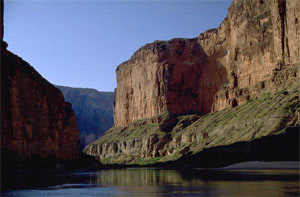 Photo:nps.gov |
Temple Butte Limestone
The Temple Butte Limestone is placed in the Paleozoic Era, Devonian Period. The fossils there are marine fossils: massive stromatoporoid sponges, rugose corals, tabulate corals, brachiopods, trilobites, placoderm fish, conodonts. (Hill,et al.,Ch13) The projected age is 385 Myr (Hill et. al., Karlstom, et. al.).
Frenchman Mountain Dolostone
500 Myr (Karlstom, et. al.)Muav Limestone
The Muav Limestone is placed in the Paleozoic Era, Cambrian Period. The fossils there are marine fossils: early trilobites,brachiopods,echinoderms, sponges. (Hill,et al.,Ch13) The projected age is 504 Myr.(Karlstom, et. al.)
Bright Angel Shale
The Bright Angel Shale is placed in the Paleozoic Era, Cambrian Period. The fossils there are marine fossils: early trilobites,brachiopods,echinoderms, sponges. (Hill,et al.,Ch13)The projected age is 506 Myr. (Karlstom, et. al.)
Tapeats Sandstone
The projected age is 508 Myr. (Karlstom, et. al.) This layer is composed of medium-grained and coarse-grained sandstone. Ripple marks are found in its upper layers, indicative of a sea environment. It contains fossils of trilobites and brachiopods, and trilobite trails are found there.Sixtymile Formation
510 Myr (Karlstom, et. al.)
Great Unconformity
The term "unconformity" is used for a location where two layers of rock are in contact, but there is evidence that material is missing, i.e., the two layers were not formed at the same time. The "Great Unconformity" is perhaps the most famous unconformity. At some locations, the Tapeats Sandstone is in direct contact with the Vishnu Basement Rock where the time gap may be 1200 Myr.
Grand Canyon Supergroup
"A thick group of rocks known as the Grand Canyon Supergroup was deposited on top of the schist and granite. Though the group includes several rock types, it is considered as a single unit that experienced a similar history following deposition." |
The perspective for this illustration of the Supergroup was taken from Grand Canyon Explorer. The following descriptions are excerpted from that source.
The Grand Canyon Supergroup of formations shows no animal or multicellular fossils. It is placed in the late Proterozoic Era. |
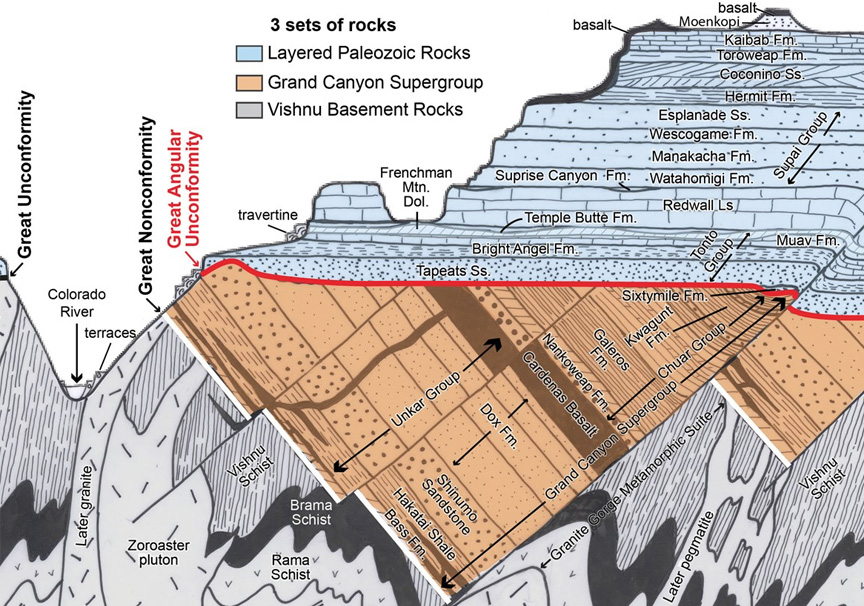 | Another depiction of the Grand Canyon Supergroup from the opposite direction comes from the National Park Services article on numeric ages. This article is part of a series adapted from the Natural Resources Report "Telling Time at Grand Canyon: 2020 Update". |
Vishnu Schist
The precambrian rock that forms the "basement" for the grand staircase strata is generally called Vishnu Basement Rocks, which appear to be of volcanic origin and have been lifted from deeper locations in the time period between 1750 and 1660 Myr. Vishnu Schist is one component of the crystalline basement rock. Another component of basement rock is Elves Chasm Gneiss, which is thought to date to about 1840 Myr. It is in the form of igneous intrusions (called plutons) and contains iron and magnesium rich (mafic) materials. No fossils have been found in this basement rock. It is placed in the early Proterozoic Era. The projected age is 1700-1850 Myr.
Zoroaster Granite
Zoroaster Granite intruded into the Vishnu Schist at the base of the Grand Canyon. The Zoroaster Granite has a characteristic age of 1740 Myr.
A list of the Vishnu Basement Rocks with numeric ages may be found in the National Park Service publication Numeric Ages of Grand Canyon Rocks.
| Examples of sedimentary rock |
| Geological time scale |
References:
Geophysics
Karlstrom, Crossey, Mathis and Bowman, Telling Time at Grand Canyon National Park
Hill, C., et al.
The Grand Canyon, Ch 3
Lutgens and Tarbuck
Ch 6
Grand Canyon Explorer
| HyperPhysics*****Geophysics | R Nave |
